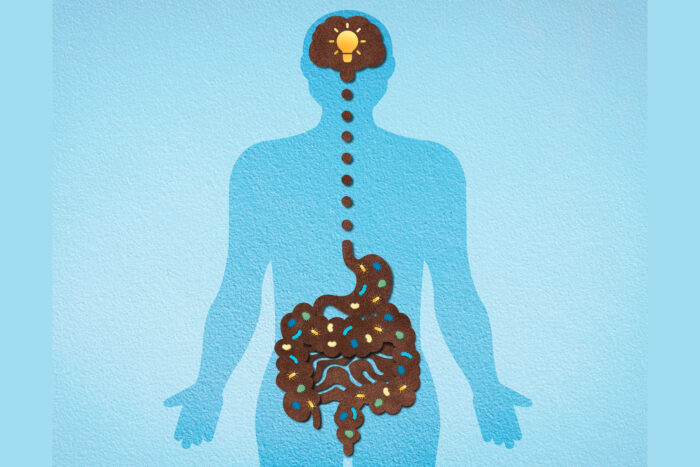Altered gut bacteria may be early sign of Alzheimer’s disease
Gut microbes of people with pre-symptomatic Alzheimer’s differ from those of healthy people
 Getty Images
Getty ImagesAlzheimer’s disease causes changes to the brain that begin two decades or more before symptoms appear. A study by researchers at Washington University School of Medicine in St. Louis reveals that the bacteria that live in the gut also change before Alzheimer’s symptoms arise, a discovery that could lead to diagnostics or treatments for Alzheimer’s disease that target the gut microbiome.
People in the earliest stage of Alzheimer’s disease — after brain changes have begun but before cognitive symptoms become apparent — harbor an assortment of bacteria in their intestines that differs from the gut bacteria of healthy people, according to a study by researchers at Washington University School of Medicine in St. Louis.
The findings, published June 14 in Science Translational Medicine, open up the possibility of analyzing the gut bacterial community to identify people at higher risk of developing dementia, and of designing microbiome-altering preventive treatments to stave off cognitive decline.
“We don’t yet know whether the gut is influencing the brain or the brain is influencing the gut, but this association is valuable to know in either case,” said co-corresponding author Gautam Dantas, PhD, the Conan Professor of Laboratory and Genomic Medicine. “It could be that the changes in the gut microbiome are just a readout of pathological changes in the brain. The other alternative is that the gut microbiome is contributing to Alzheimer’s disease, in which case altering the gut microbiome with probiotics or fecal transfers might help change the course of the disease.”
The idea of studying the connection between the gut microbiome and Alzheimer’s disease came together at a youth soccer game, where Dantas and Beau M. Ances, MD, PhD, the Daniel J. Brennan Professor of Neurology, chatted while their children played. Ances treats and studies people with Alzheimer’s disease; Dantas is an expert on the gut microbiome.
Scientists already knew that the gut microbiomes of people with symptomatic Alzheimer’s differ from the microbiomes of healthy people of the same age. But, Ances told Dantas, nobody had yet looked at the gut microbiomes of people in the critical pre-symptomatic phase.
“By the time people have cognitive symptoms, there are significant changes that are often irreversible,” said Ances, the other co-corresponding author. “But if you can diagnosis someone very early in the disease process, that would be the optimal time to effectively intervene with a therapy.”
During the early stage of Alzheimer’s disease, which can last two decades or more, affected people accumulate clumps of the proteins amyloid beta and tau in their brains, but do not exhibit signs of neurodegeneration or cognitive decline.
Dantas, Ances and first author Aura L. Ferreiro, PhD, then a graduate student in Dantas’ lab and now a postdoctoral researcher, evaluated participants who volunteer for studies at the Charles F. and Joanne Knight Alzheimer Disease Research Center at Washington University. All participants were cognitively normal. As part of this study, participants provided stool, blood and cerebrospinal fluid samples; kept food diaries; and underwent PET and MRI brain scans.
To distinguish participants already in the early stage of Alzheimer’s disease from those who were healthy, the researchers looked for signs of amyloid beta and tau accumulation through brain scans and cerebrospinal fluid. Of the 164 participants, about a third (49) had signs of early Alzheimer’s.
An analysis revealed that healthy people and people with preclinical Alzheimer’s disease have markedly different gut bacteria — in terms of the species of bacteria present and the biological processes in which those bacteria are involved — despite eating basically the same diet. These differences correlated with amyloid and tau levels, which rise before cognitive symptoms appear, but did not correlate with neurodegeneration, which becomes evident about the time cognitive skills start to decline. These differences potentially could be used to screen for early Alzheimer’s disease, the researchers said.
“The nice thing about using the gut microbiome as a screening tool is its simplicity and ease,” Ances said. “One day individuals may be able to provide a stool sample and find out if they are at increased risk for developing Alzheimer’s disease. It would be much easier and less invasive and more accessible for a large proportion of the population, especially underrepresented groups, compared to brain scans or spinal taps.”
The researchers have launched a five-year follow-up study designed to figure out whether the differences in the gut microbiome are a cause or a result of the brain changes seen in early Alzheimer’s disease.
“If there is a causative link, most likely the link would be inflammatory,” said Dantas, who is also a professor of pathology & immunology, of biomedical engineering, of molecular microbiology and of pediatrics. “Bacteria are these amazing chemical factories, and some of their metabolites affect inflammation in the gut or even get into the bloodstream, where they can influence the immune system all over the body. All of this is speculative at this point, but if it turns out that there is a causal link, we can start thinking about whether promoting ‘good’ bacteria or getting rid of ‘bad’ bacteria could slow down or even stop the development of symptomatic Alzheimer’s disease.”






